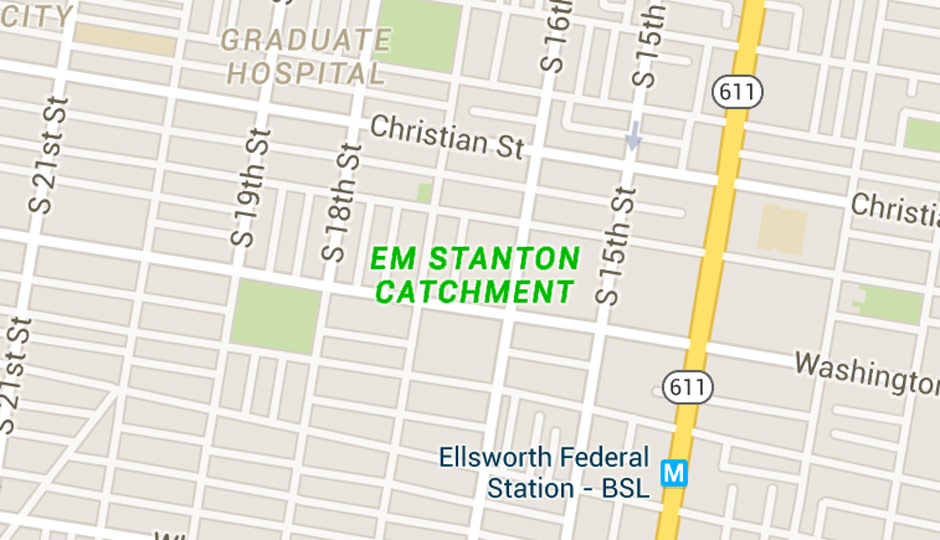What Is Up With Google Maps’ “EM Stanton Catchment” Neighborhood?

The “EM Stanton Catchment” neighborhood that exists on Google Maps
Load Google Maps into your browser and search for Philadelphia. Scroll down from City Hall and you’ll see a strange neighborhood you might not know: E.M. Stanton Catchment.
As you might have guessed, E.M. Stanton Catchment isn’t an actual neighborhood. No one Philadelphia magazine spoke with had ever heard people referring to the area as “E.M. Stanton Catchment.” It’s literally just the catchment area for Edwin M. Stanton Elementary School in South Philadelphia. The official Google boundaries do not match up with the actual catchment map, but it’s roughly in the right area. Per this commenter at Curbed, it first showed up sometime last year.
Stanton is a good, small school with an active community, and it successfully resisted closure in 2012. But it doesn’t seem that anyone refers to that neighborhood as E.M. Stanton Catchment, or E.M. Stanton. Confusingly, there is already a Stanton neighborhood in Philly. It’s between Strawberry Mansion and Broad Street, per the city, and sort of overlaps with the Cecil B. Moore neighborhood. (Google Maps lists Stanton, too.)
Google declined an interview request from Philadelphia magazine regarding the E.M. Stanton Catchment neighborhood, but Mara Harris of the Maps team did answer a few questions about how Google gets its neighborhood data.
“The various types of data found on Google Maps comes from a wide range of sources,” Harris emailed. “Our basemap data (things like place names, neighborhoods, borders, and road networks) comes from a variety of authoritative public and commercial data sources, user contributions, and imagery references.”
So why does this “E.M. Stanton Catchment” neighborhood matter, other than as a curiosity? Google is such an authoritative source that there is a Wikipedia page for this E.M. Stanton Catchment neighborhood. (The sources are mainly links to stories about Hawthorne, a different Philadelphia neighborhood.) With Wikipedia’s reach and open-content policy, the E.M. Stanton neighborhood will no doubt reside on other online resources. If you simply need to know, the Wikipedia page was created in June by Wikipedian Brassknuckles89.
Philadelphia magazine writer Malcolm Burnley wrote earlier this year of a Harvard study that suggests race (and, Burnley writes, the old/new divide) plays a part in what we call neighborhoods. To oldheads, it’s just South Philly. To a new resident, it might be Newbold or Dickinson Narrows or whatever. Google Maps is loaded with these new neighborhood names.

Google Maps’ South Philly ’hoods.
Newbold is the old name of Hicks Street; when developer John Longacre created a civic association for that area in 2003, he decided to use that name. (The Inquirer’s Inga Saffron reported two years ago that “though some old-timers resent the name change, it seems to be sticking.” The first time most people (anyone?) heard of Dickinson Narrows was when it was named the second-hottest neighborhood in the country in January by realty site Redfin.
Hottest South Philly neighborhoods (con’t): Refinery City, Blavat Estates, Xfinity Town!, Newbold, Forgotten Top, New Malmö, Stripclubville
— Dan McQuade (@dhm) January 23, 2015
It’s understandable Google Maps would pick up realtor-invented neighborhood names. Some realtor-invented names become accepted by communities. And Google Maps is generally good. Much of Google Maps’ Philadelphia neighborhoods are accurate — Google even remembers Forgotten Bottom! Google’s reach is so great they literally have some power to redefine the names of areas thousands of miles away from their California campus. Who knows, maybe “E.M. Stanton Catchment” will be treated as a hot new neighborhood now that Google has deemed it so.
But there’s something strange about Google’s ability to change the name of an area (albeit unintentionally). It was just last year Google Maps removed Temple Town from its map after residents of the Cecil B. Moore area (or maybe even the actual Stanton neighborhood) complained. Realtors will always have the ability to try to rename neighborhoods to make them more desirable. Now they have Google’s help, too.
That doesn’t apply to our mystery neighborhood, really. How the “E.M. Stanton Catchment” neighborhood got on the site remains confusing. Google won’t say. But you might be able to fix it, just like Cecil B. Moore’s residents did. “We always encourage users to contribute their local knowledge and updates to the map using Google Map Maker,” Harris emailed. “Or let us know when something is incorrect by using our ‘Report a Problem’ tool, found at the bottom right corner of the map.”
At least one person has complained to Google about the neighborhood, but it apparently didn’t register with Google. For now, the E.M. Stanton Catchment neighborhood lives on. Maybe one day it will get so hot it will be renamed by a realtor. How about just “EMS”? That has a nice ring to it.
Follow @dhm on Twitter.